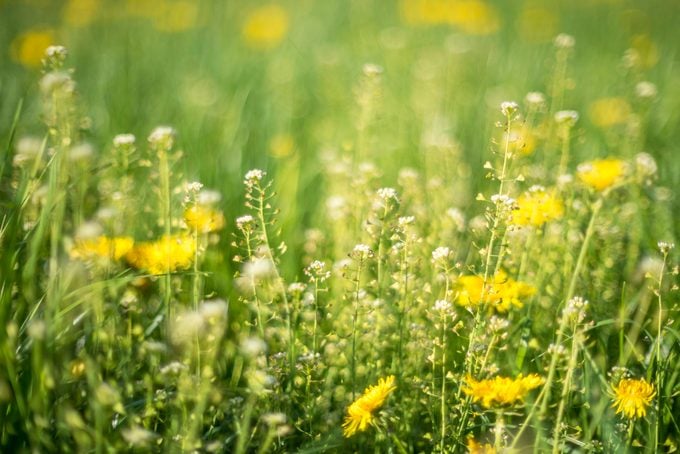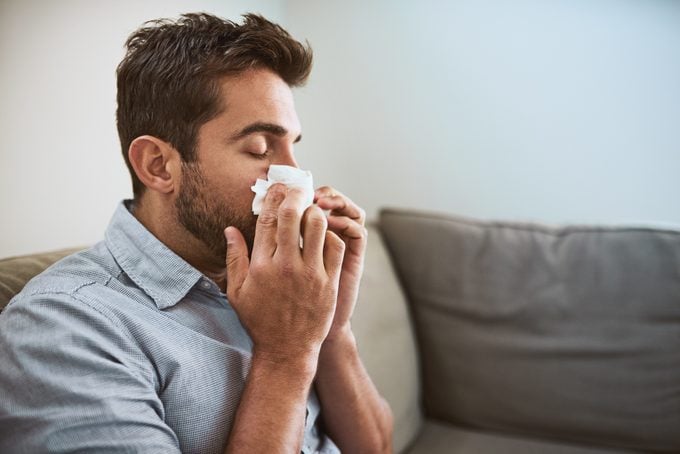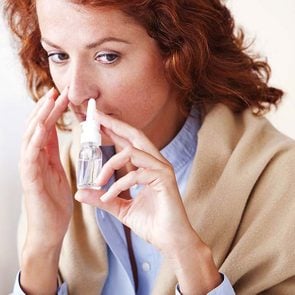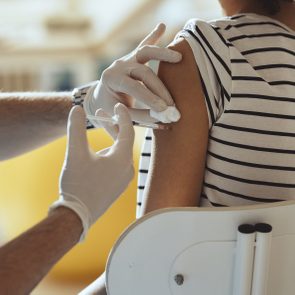A Guide to Pollen Allergy Symptoms and Treatments
Updated: Mar. 08, 2022
Pollen allergy symptoms can really wipe you out with a host of miserable issues. Here's how to recognize pollen, manage symptoms, and breathe easier if you have a pollen allergy.
On This Page
What are pollen allergies?
If you have allergies, you don’t need to be outside long to know if it’s pollen season. Your nose will be the first to alert you of an impending allergy attack.
First, there’s sneezing and a runny nose. Then come the teary and itchy eyes. It seems you’re simultaneously blowing your nose and wiping your eyes all day, making it virtually impossible to enjoy your day.
Whether you’re only allergic to ragweed, or a combination of trees, weeds, and grasses, pollen allergies can sure make it the season of discontent.
Here’s what you need to know about pollen allergies, including the causes, symptoms, and treatments for allergies.

What is pollen, and what does pollen look like?
The pollen that initiates the assault on your nasal passages comes from anemophilous (wind-pollinated) plants, trees, grasses, and weeds.
Pollen is a fine powder made of pollen grains that fertilize other plants of the same species via the wind.
It’s so tiny that most of the time, you can’t see it until the pollen count is high, and it cakes your car and outdoor furniture with yellowish-green dust. Yet, you don’t have to have wind-pollinated plants in your yard or even your neighborhood to start sneezing.
Because pollen is so fine and lightweight, it spreads effortlessly via the wind. It can spread for miles and miles, from city to city.
If you’re wondering about the pollen in large, colorful, and fragrant flowers, such as roses and jasmine, or flowering trees, people with allergies generally don’t need to worry about them.
They are entomophilous plants, and insects such as bees, carry the pollen from plant to plant, not the wind. These types of plants usually don’t cause as many issues with people who have allergies.
What plants cause pollen allergies?
So we know wind-pollinated plants are a problem but what specific plants, trees, weeds, and grasses have the potential to ruin a perfect picnic on a summer day?
There are hundreds of plants that have the potential to give you the sniffles, but allergists know the “usual suspects” that affect people the most.
For grass pollen, it’s often perennial rye, Kentucky bluegrass, Bermuda grass, Timothy grass, redtop grass, and Johnson grass.
When it comes to weeds, ragweed is the worst of the worst, especially the tooth-leaved and tall goldenrod species. Runner ups include tumbleweed, sagebrush, lamb’s quarters, and pigweed.
There’s a forest of tree species that can cause pollen allergy symptoms, namely aspen, alder, ash, birch, cedar, oak, elm, birch, box elders, cottonwood, poplar, beech, mulberry, pecan, and olive trees.
The only definitive way to know which pollen you are allergic to is by getting an allergy test. (More on that later)
What is a pollen allergy?
When you have a pollen allergy, doctors diagnose it as “allergic rhinitis,” commonly referred to as hay fever.
When the tiny particles of pollen sneak into your nose, your body sees it as a foreign substance. It’s still a mystery to scientists why the body overreacts, but it’s no secret how the body reacts.
As soon as you breathe it in, the body goes into battle mode to kick the allergens out. It churns out antibodies called immunoglobulin E (IgE). These antibodies travel to cells that release histamines and other chemicals.
That all sounds well and good, except it’s not. The histamines irritate and inflame the nasal passage, triggering a drippy nose or feeling plugged up, plus watery or itchy eyes, among other tiresome symptoms.
No one is exempt from pollen allergens; however, a family history of allergies or asthma could put you at a greater risk of developing them.
Pollen allergy symptoms
As soon as your nose gets a whiff of pollen, it triggers inflammation and irritation in the nose. You might experience one symptom or a combination of the following pollen allergy symptoms: Pollen also elicits one or a combination of these symptoms:
- Sneezing
- Watery eyes
- Allergic shiners
- Runny nose
- Stuffy nose
- Itchy throat
- Itchy ears
- Itchy eyes
- Redness and swelling around the eyes
- Itchy mouth
- Throat clearing
- Wheezing
- Coughing
- Tiredness
Complications of pollen allergy symptoms
If sniffing all day and going through a box of tissues weren’t agonizing enough, pollen allergens can open the door to more problems.
The pollen from trees, weeds, and grasses can be similar to proteins found in certain fruits, veggies, nuts, and seeds. So when you eat the food, your immune system cross reacts to the food too. It’s called oral allergy syndrome.
For example, about 50 to 75 percent of people who are allergic to birch pollen react to certain foods, like pitted fruit, carrots, or even some nuts. People with oral allergy syndrome might experience an itchy mouth and throat and tingling lips and tongue after eating certain foods.
Nasal congestion can sometimes lead to sinus pressure and a painful allergy headache or sinus infection, says Daniel Sullivan, MD, an otolaryngologist and surgeon specializing in allergies at the Health First Medical Group in Melbourne, Florida.
Lingering nasal inflammation can also be a breeding ground for other organisms.
“If you have an allergy flare and get exposed to viruses or bacteria at work, you’re much more likely to get sick than if your allergies were under good control and you didn’t have that inflammation already there,” says Dr. Sullivan.
Pollen allergens can also be a major contributor to asthma for some people, and pollen can trigger asthma attacks.

How is a pollen allergy diagnosed?
If you’re getting stuffed up at the same time every year, you might blame pollen, but pollen allergy symptoms also can feel a lot like a cold or other medical conditions that are easily mistaken for allergies. The only definitive way to determine if you have pollen allergies is to be tested by an allergist.
The most common type of allergy test is the skin prick test. A blood test may be an option for those with a skin condition such as psoriasis or who are taking certain medications that interfere with skin testing. Your doctor might also recommend a blood test to help further identify allergy triggers or shed light on skin prick test results.
Doctors conduct a skin prick test by placing a small amount of the suspected allergens on the skin, and using a small device to scratch the skin to introduce the allergen. You can be tested for several allergens simultaneously. So, if you suspect you are also allergic to pet dander, mold, or dust mites, your doctor may suggest this route.
If the results of a skin prick test are negative, you may also get an intradermal test, which involves injecting a tiny amount of diluted allergen under the skin. You might feel a slight prick at the allergen injection.
You won’t have to wait for days or weeks for test results with these two tests. Redness, swelling, or a rash will appear at the test site in no more than 15 minutes if you are allergic.
It’s very rare, but anaphylaxis (a whole-body allergic reaction that can be life-threatening) may occur. Your allergist is well-prepared to treat you quickly if it happens.
When does pollen season start and end?
A better question might be, when isn’t it pollen season? Aside from the freezing temps of winter, pollen-producing plants send pollen flying in the spring, summer, and fall.
Of course, if you live in a warmer climate, “winter” may actually be one of the worst times for pollen. Dr. Sullivan says oak and pine are particularly prolific in his central Florida location in February and March.
That said, tree pollen generally starts flying from March to April or May. Grass pollen pops up in late spring, and ragweed pollen peaks in the fall, around September, and lingers till October, Dr. Sullivan says.
Scientists are starting to see a shift in those timelines because of climate change. A 2021 study published in Scientific Reports found pollen season lengthened by about half a week per year during the seventeen-year study in the San Francisco Bay area.
“The pollen season is eight to nine weeks longer than it was in 2002,” says one of the study’s authors, Mary Prunicki, MD, director of air pollution and health research at the Sean N. Parker Center for Allergy and Asthma Research at Stanford University.
Additional research in the Proceedings of the National Academy of Sciences showed similar findings—pollen season is starting earlier and lasting longer across the country.
What factors affect how severe allergy season is?
The weather and pollen count have the potential to make allergy symptoms even worse.
For instance, because pollen is so light, it can spread profusely when the weather is hot, dry, and windy. Those are the days you can visually see it in the air and accumulate on your car.
Rainy days can also be an issue. A heavy downpour can break down pollen into submicrometer pollen fragments, which can penetrate deeper into the respiratory system and linger longer in the atmosphere as much as 11 hours after heavy rain.
Finally, if you have known pollen allergies and don’t take your allergy medicine ahead of the season or wait too long after exposure, you could be setting yourself up for more symptoms.
Once nasal inflammation sets in, it usually takes much longer for the medicine to work. Or it might not at all, leading to more severe symptoms, says Tina Sindher, MD, an allergist at Stanford Health Care in San Jose, California.
“It’s the cumulative effect that can really wipe people out,” Dr. Sindher says.
How to treat pollen allergies
Ask a room of 100 allergists the best way to treat allergies, and they would all say the same thing—avoid allergens. No, that wasn’t a bad joke. It’s totally true. Except, it’s not always feasible unless you live in a plastic bubble.
Of course, there are things you can do at home and while you’re out to mitigate allergens from entering your nose. (Keep reading for suggestions.)
When pollen allergen exposure is unavoidable, there are several options to hinder or halt the histamines that ruin your day.
Saline nasal rinses
This treatment is an excellent first line of defense, especially if you just came indoors during pollen season, Dr. Sindher says.
However, some people aren’t that happy about having to use a bulb or neti pot to shoot water up their nose while leaning over the bathroom sink.
“They are not a popular option because people don’t like to use them, but they are very effective at flushing out the allergens,” Dr. Sinder says.
Antihistamines
Antihistamines fall into two categories. Diphenhydramine (Benadryl), a first-generation example, is one of the most effective, Dr. Sullivan says.
“The trouble is it makes about 90 percent of folks really sedated,” says Dr. Sullivan.
That might be an option better suited for bedtime.
Second-generation antihistamines, such as Claritin, Zyrtec, and Allegra, are similar to each other and tend to be less sedating, Dr. Sullivan says. “People have favorites that work for their body and should stick to the one that works for them.”
Timing is everything with antihistamines. Unlike other medicine you take after a symptom pops up, antihistamines are most effective when used as a preemptive strike before exposure to the allergen and symptoms develop.
If over-the-counter options aren’t effective, a doctor can prescribe a stronger dose.
Nasal sprays
Nasal sprays that contain inflammation-fighting steroids might not feel as weird and invasive as nasal rinses and are a good option for controlling nasal drip and helping nasal congestion Dr. Sullivan says. The downside—they may take a while to kick in.
“It may take up to two months to realize the full benefits, so you have to use them very consistently,” advises Dr. Sullivan.
Decongestants
What’s worse? A runny nose you’re constantly wiping or a stuffy nose that makes it hard to breathe freely? Before you take a decongestant in pill or via a nasal spray, read the product’s label, especially if you have a heart condition, high blood pressure, or stroke.
“Any medication with a “D” after it definitely raises your heart rate and blood pressure,” says Dr. Sullivan.
Over-the-counter medications like some types of Sudafed or those with “D” in the name, like Claritin-D or Zyrtec-D, contain pseudoephedrine, a decongestant that can also cause anxiety, a racing heart, or sleep problems.
“It will help decongest the nose and help with the drip and drainage, but usually the tradeoff is not good,” cautions Dr. Sullivan.
Make sure to read product labels and use an allergy or cold medicine that’s safe for high blood pressure.
Saline eye drops
Similar to a saline nasal rinse as they help flush out irritating allergens from your eyes.
Antihistamines should take care of allergy eye symptoms, but saline drops can bring soothing relief quickly.
Allergy shots
Allergy shots may help people whose pollen allergy symptoms return again and again. They have the potential to give long-term relief or even remission of pollen allergy symptoms. That is, if they work.
Dr. Sindher says a third of her patients get complete relief. Another third of her patients see some improvement, and a third find no relief or have such bad reactions to the shots they must discontinue.
Skin patch testing is required to determine the shot’s dilutions, safety, and efficacy.
Sublingual tablets
Sublingual tablets, also known as sublingual immunotherapy (SLIT), are relatively new to the allergy treatments arsenal. They work the same way as allergy shots, increasing your tolerance to an allergen over time, but are in a pill form that melts in your mouth.
An allergy test is needed first to identify what allergen affects you. And that’s where sublingual tablets are limited.
Currently, there are versions available to treat ragweed, some grass pollens, and dust mites. So if your pollen allergy doesn’t fit into one of those categories, or more than one allergen affects you, sublingual tablets might not be a good fit.
Tips for living with pollen allergies
If you could blow away every allergen before it reached your nose, you would be in the clear. Since that isn’t realistic, here are some tangible ways to pollen-proof yourself and your home.
Check on the pollen count in your area
The daily pollen count and extended forecast can help you plan your attack against allergies.
Dr. Sindher recommends taking allergy medicine one to two weeks before pollen season begins.
Limit your exposure outside
Don’t touch your nose, and wash your hands often. Close the windows in your house and roll up the windows in the car.
When you’re outside, wear a hat and sunglasses and a surgical or N95 mask
Leave your shoes by the door and put your clothes in the hamper, then shower and shampoo your hair.
Limit your exposure inside
Wash the clothes you wore outside before wearing them again. Don’t dry them on a clothesline outdoors. Speaking of laundry, wash bedding in hot, soapy water once a week.
Use air conditioning if you have it, close the windows in your house, and roll up the windows in the car. Air purifiers can be very effective for cleansing your home of pollen when you choose the right air purifier.
If you’re working from home, you might want a portable or personal air purifier that moves with you if you change locations.
Filters can be pricey and should be replaced every three months. If you have central air conditioning, installing high-quality HEPA filters is more practical, and cost-effective Dr. Sullivan says.
Don’t snuggle with your pet
We saved the hardest for last. Your pet may give you unlimited love and affection, but it may come at a price during pollen allergy season.
Cats and dogs frolic in pollen when they’re outside and then track it indoors. Bathe your pet often and don’t sleep in the same room if your pollen-coated pet aggravates your allergies.
And because most of the time is spent in the bedroom sleeping, Dr. Sullivan also suggests running an air purifier with a HEPA filter in your bedroom and closing the door, as the filter will get clogged with pet hair/fur quickly if your pet is allowed in the bedroom.



